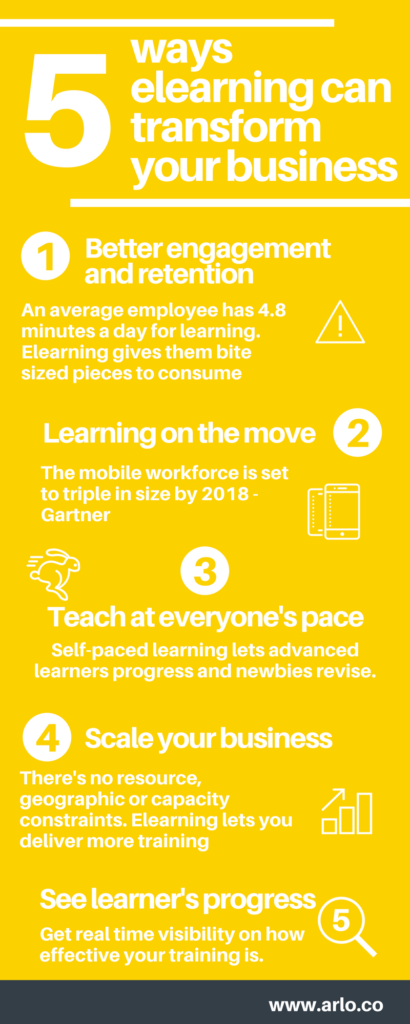Recently updated on September 30th, 2019
If you only provide face-to-face training with no elearning, you are missing out. Face-to-face training has many limitations. Face-to-face courses take longer periods of time, involve costs such as travel and do not cater to every learner. Elearning has drastically changed the training and learning industry and is rapidly growing. Training companies are no longer bound by physical constraints such as location or resources and learners now have the flexibility to learn at their own pace. eLearning has grown 900% since the turn of the millenium and the LMS market is on track to be worth $240 billion by 2023 (elogic Learning). Continue reading to understand five ways which elearning could transform your business.
Elearning gives you better engagement and retention
We’ve all been in training sessions where the presenter is not engaging, the duration is too long and we recall very little. Most employees have little time to spend on training. So when they do attend training, that time is often wasted. The average employee has 1% of their working week available to professional development, which equates to 4.8 minutes a day (Delloite). Elearning unlike face-to-face courses allows you to deliver learning material in bite-sized pieces online. Therefore, registrants don’t have to take excessive amounts of time off from their work to travel.
Elearning has been found to increase retention rates from 8% in face-to-face courses to up to 60% when completed online (Shift Learning). One trend within the elearning industry making this statistic a reality is ‘Gamification’. Gamification within elearning is the process of applying game principles to encourage further and deeper learning. For example, this may be awarding badges or trophies for the completion of a certain level of course material. Delloite found that 80% of learners claimed their learning would be more productive if it were more game orientated.
Elearning also allows you to cater for multiple learning types. Using different methods of education such as video, articles, quizzes and activities will increase engagement compared to the monologue of traditional face-to-face courses.
Elearning allows you to deliver training on the move
According to Gartner, the mobile workforce is going to double or triple in size by the year 2018. Mobile devices are becoming more advanced, capable of completing increasingly consuming tasks. This has liberated people from the desktop and desk. Learners will have the option of picking up your material outside of the classroom. More opportunities to learn via mobile, during commuting time, or at home, will increase the time available for learning. With only 1% of the working week on average available for development, more time for learning is an improvement.
Learning that is not too fast and not too slow, but just right
Elearning is self-paced. The registrant is able to choose when they want to consume more material. Registrants can skip content they are already familiar with, go back to cover pieces they need more work on and participate when it suits them. This flexibility in delivery is hard to achieve face-to-face as you will often have to neglect someone in the room. Either you will move through the material to slowly for the advanced learner, or you will go to quickly for the newbie, which we ourselves experienced when we attended a training course. You also have a limited amount of time before your registrants need to go back to their real work. With elearning this isn’t a problem, learners can choose when to consume, how far they want to advance and how long they want to revise.
elearning helps you scale your training business
Many of the limitations of face-to-face learning are removed with elearning. Elearning can be achieved without the presence of an instructor. Presenter availability and resourcing is no longer an issue when using elearning. Venue capacity is no longer a concern either as the training moves online. Geographic limitations are reduced as elearning can be deployed anywhere and anytime. There is no commute to the venue and any location can be serviced globally. Reduction of resource, capacity and geographic limitations means it is easier for your business to scale. You can increase the number of registrations you take and serve more people.
LMS gives you insight into your learners’ progress
Elearning solutions such as Learning Management Systems will often give you real time visibility of a learners journey, which would otherwise be unseen when using more traditional methods of training. This real time feedback allows you to make changes to your offering when you identify a lack of progress. They often integrate with training management software to so you can manage elearning registrations and payment.
Technological improvements and attention scarcity now makes elearning a vital part of any training organisation. If you are not utilizing elearning in your offering you are missing out on these five effects and stand the risk of leaving money on the table. Give you learners the best experience by increasing accessibility, personalization and scalability. To learn more about elearning solutions get in touch, we would love to show you how we could help!
Check out the benefits of elearning infographic below:

3 comments
Comments are closed.

Great list and one I will be sure to pass along to all my clients and will be looking to incorporate some of them into my own use.
Great post.
Thank you very much
Thank you so much for writing this.